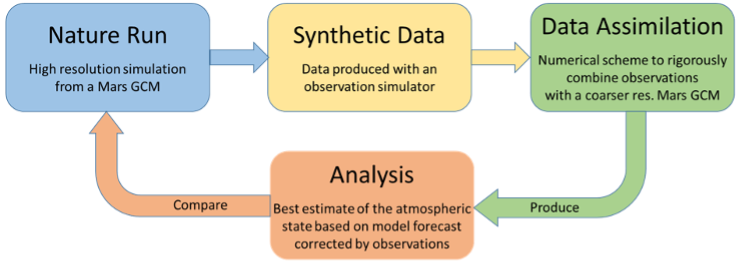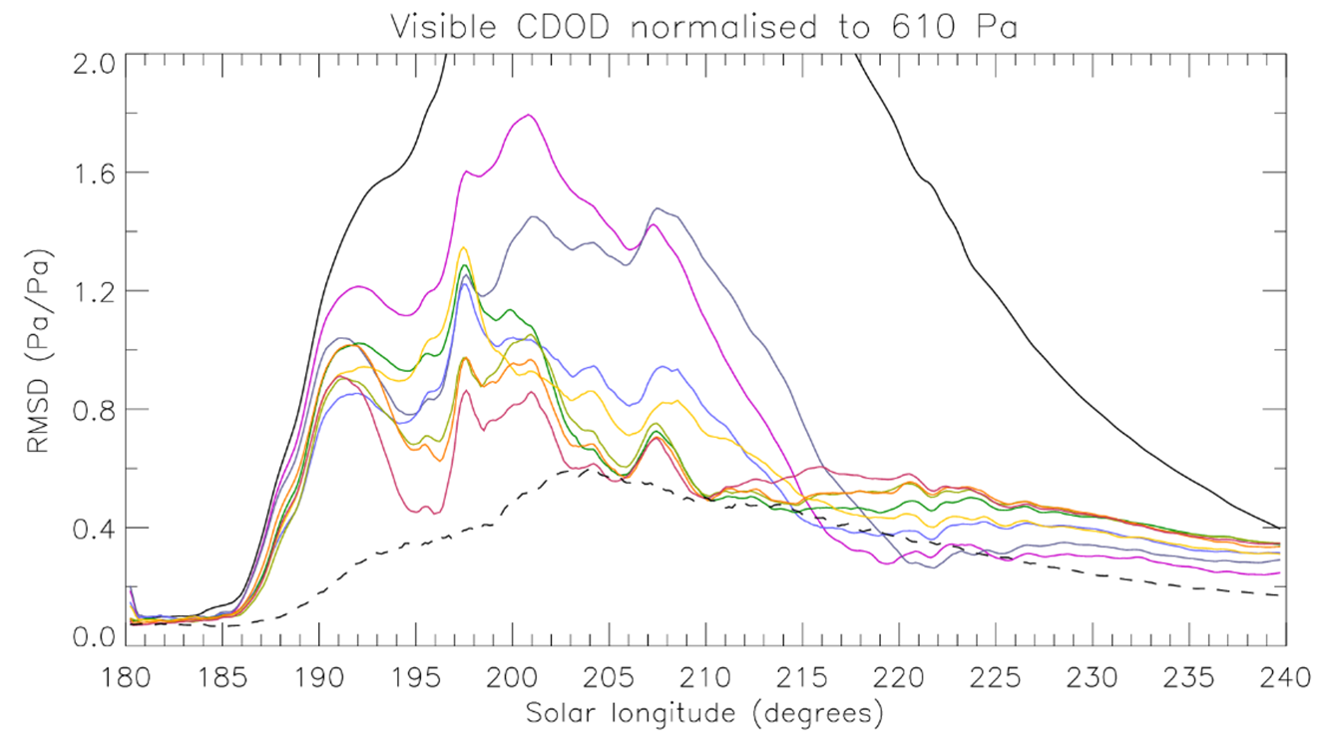Assessing the impact of present and future orbiters on Mars weather monitoring using data assimilation
- 1Department of Physics, SUPA, University of Aberdeen, King’s College, Aberdeen, UK
- 2Department of Physics & NSSTC, United Arab Emirates University, Al Ain, UAE
- 3Centre for Mars Meteorology Monitoring, Paneureka, Le Bourget-du-Lac, France
- 4Laboratoire de Météorologie Dynamique, IPSL/CNRS/Sorbonne Université, Paris, France
- 5Space Science Institute, Boulder, CO, USA
- 6Telespazio Belgium SRL for ESA - European Space Agency
- 7ESA-ESTEC, Noordwijk, Netherlands
To inform future Mars spacecraft development, it is important to understand the impact of new observational platforms on our ability to measure Mars’ global climate properties and to identify weather patterns in the Martian atmosphere. In particular, recent studies have begun to focus on constellations of multiple orbital weather-monitoring satellites in anticipation of new missions to Mars in the coming decade [1-4].
We present a series of Observing System Simulation Experiments (OSSEs) that were carried out to determine the optimal configuration and payload for potential future weather-monitoring satellites. This is based on the ability of a data assimilation system to reproduce the atmospheric state under clear, global dust storm, and regional dust storm conditions, while accounting for observational uncertainties.
Method
To simulate the impact of atmospheric observations that do not yet exist for Mars, we used an “Observing System Simulation Experiment” (OSSE) framework. This approach has been applied for more than 30 years to evaluate the effects of future instruments on monitoring the Earth’s climate system. Our OSSE framework had three components:
First, the Nature Run (NR) was a GCM simulation at higher-than-standard spatial resolution, which represented the true state of the atmosphere. The point of using the OSSE framework is that the true state of the atmosphere is known exactly; something that is not possible with real atmospheres. This allows us to isolate the differences between observing platforms rather than focusing on the differences between model and reality. For the NR we used the Mars PCM [5] at 2o x 2o horizontal resolution. The NR covered three meteorologically different 60o-Ls periods during Mars Year (MY) 34, shown in Fig. 1: a clear period with no dust storms (Ls = 60-120o), a period with a global dust storm (Ls = 180-240o), and a period with a regional dust storm (Ls = 300-360o).

Figure 1: Mars Year 34 infrared column dust optical depth as a function of time of year and latitude [6]. The three study periods are indicated by boxes [4].
Second, the synthetic observations were created to mimic as closely as possible what an instrument would observe if it were observing the simulated Mars atmosphere. Our synthetic observations represented retrievals of atmospheric temperature profiles, dust opacity profiles, and column dust optical depth measurements made by the existing instruments MRO-MCS, ExoMars TGO-ACS-TIRVIM, and EMM-EMIRS, and proposed or desirable future instruments, such as a low-altitude near-polar orbiter that cycles through the full range of local times over 14 sols, a 5720-km altitude low-inclination orbiter, and areostationary orbiters, along with various combinations of these spacecraft. The experiments varied the instruments studied (point and imaging radiometers observing in the thermal infrared) and observational strategies (nadir, off-nadir, and limb).
Finally, the data assimilation scheme combined the observations and GCM at “standard” spatial resolution (5.625o x 3.75o) into a sequence of “reanalyses”, and we compared these reanalyses with the “true” state of the atmosphere in the NR. We used the Local Ensemble Transform Kalman Filter (LETKF) with 36 ensemble members [7]. Figure 2 illustrates the process schematically.

Figure 2: Flow diagram showing an Observing System Simulation Experiment for Mars [4].
Results
We quantified the accuracy of each reanalysis by computing several diagnostics, foremost among which was the root-mean-square difference (RMSD) between the reanalysis and the NR (“truth”). This was computed for observed variables (temperature, dust) and for unobserved variables (surface pressure, horizontal wind components). The latter are updated dynamically by the GCM during the assimilation process so that they converge (in principle) to a state where they are in balance with the measured temperature field, within observational uncertainty. We also studied higher order diagnostics such as the amplitude and phase of the thermal tides.
Figure 3 shows an example of the column dust optical depth RMSD throughout the global dust storm period, for several instrument configurations.

Figure 3: Visible column dust optical depth RMSD normalised to 610 Pa during the global dust storm period of Mars Year 34 [4]. The RMSD is an area-weighted, global average of the difference between the reanalysis and the Nature Run. Individual lines include a GCM simulation using a climate dust scenario with no observations assimilated (black), MRO-like observations (magenta), a near-polar low altitude orbiter (grey), three areostationary platforms (olive), and combinations of areostationary and other orbiters (yellows and greens). Some other lines show configurations that will not be included in the presentation. The dashed black line is the observational error.
In dust storm conditions, the ability of the assimilation to correctly reconstruct the weather generally increases with the comprehensiveness of the observing constellation, in terms of the number of platforms, spatial coverage, and variety of observations. While several orbital configurations perform equally well when looking at global or daily-averaged meteorological fields, significant differences between configurations emerge when looking at the diurnal cycle or at regional scale. Large observational uncertainties greatly affect the accuracy of the results.
Outlook
This approach can be applied to constellations of SmallSats focused on Mars weather monitoring, assuming the availability of simple payloads dedicated to temperature and dust observations. The assessment of the effect of direct wind measurements (e.g., using a Doppler LIDAR or sub-mm sounder on larger orbital platforms) and the impact on the weather forecasting capability would be valuable topics for follow-on studies.
Acknowledgments
This work was carried out partly under the ESA SWIMALONG project, contract number 4000138021/22/NL/DB. RY was supported by UAE University grants G00003322 and G00003407.
References
[1] Montabone et al. (2020), NASA White Paper, Bull. AAS, 53, 281, 10.3847/25c2cfeb.0cdca220.
[2] Montabone et al. (2020), Access2Space Workshop, JHU APL.
[3] Montabone et al. (2021), EPSC2021-625, 10.5194/epsc2021-625.
[4] Montabone et al. (2023), ESA report SWIM-OU-TN-002, contract no. 4000138021/22/NL/DB.
[5] Forget et al. (1999), JGR Planets, 104(E10), 24155-24175, 10.1029/1999JE001025.
[6] Montabone et al. (2020), JGR Planets, 125, e2019JE006111, 10.1029/2019JE006111.
[7] Young et al. (2022), JGR Planets, 127, e2022JE007312, 10.1029/2022JE007312.
How to cite: Young, R., Montabone, L., Millour, E., Paardekooper, D., Parfitt, C., and Wilson, C.: Assessing the impact of present and future orbiters on Mars weather monitoring using data assimilation, Europlanet Science Congress 2024, Berlin, Germany, 8–13 Sep 2024, EPSC2024-1029, https://doi.org/10.5194/epsc2024-1029, 2024.